- 1.1 Scope Definition
- 1.2 Mapping the Processes
- 1.3 Risk Analysis
1.2 Mapping the Processes
The step of “mapping the process” is usually misunderstood to be the activity of drawing the process flows. Although the flows play an important role during any process mapping approach, alone they do not offer visibility to the supply network mechanisms.

Figure 1.7 SNG Cycle, process map
Managing the process mapping environment requires three core primary and coordinated activities: interviewing people, observing the process, and analyzing data. The next sections explain the elements illustrated in Figure 1.8.

Figure 1.8 SNG Cycle, process mapping environment
These three core activities should follow some basic guidelines built after repeating experiences in different organizations. These guidelines are as follows:
- Interviewing principles: (1) One interviewee at a time; (2) open questions (avoid yes-no approach); (3) ongoing record and validation; (4) request complementary data; (5) draw preliminary flow during interviewing process; and (6) double-check all information received.
- Observation principles: (1) Information captured during initial interviews should be double-checked before observation starts; (2) observe the process in different moments; (3) open questions to process owners and team; (4) request complementary data; (5) use observations to revalidate preliminary flows drawn during interviews; and (6) double-check observation inputs whenever required.
- Data analysis principles: (1) Plan before requesting data; (2) understand the data received and evaluate whether it is exactly what had been required; (3) understand the context and check data adherence to the process; (4) analyze data; (5) double-check the analysis; and (6) revalidate flows previously drawn based on analysis outputs.
Following these three activities the organization needs to organize and communicate the acquired knowledge. A communication strategy is created and it is usually supported by two mechanisms: flowcharts and a supporting database (usually in the format of spreadsheets).
Once the process is mapped, the governance leaders need to capture real information on current business priorities (Figure 1.7, building block 5). Only by cross-checking the process maps and the business key demands is it possible to understand the supply network’s enhancement requirements.
The visibility of the gaps between the current process standards (“as is” scenario) and the expected performance (“to be” scenario) is the basis for enabling an appropriate risk analysis.
The evolution within different subprocesses can be simultaneously registered in the control chart introduced in Section 1.1. The following example explores this feature using the Warehousing knowledge area (SNAR 01.02.02).

Figure 1.9 Selecting SNAR 01.02.02
As explained, it is now necessary to detail which key subprocesses (KSPs) are to be observed during the SNG Cycle. The following subprocesses have been selected: (01) Receiving operations, (02) Picking operations, and (03) Shipping operations. Note that in Figure 1.10 that all three key subprocesses have an equal score (6.0).
In contrast to the previous example, the mapping process and the definition of controls may be at different stages for different subprocesses.
In this example, the organization focuses on the extended supply network and the connections with all significant suppliers (SNAR 02.03.01), customers (SNAR 02.03.02), and service providers (SNAR 02.03.03). The management of the supply network also looks at selected noncompetitors (SNAR 02.03.04) and some preferred competitors (SNAR 02.03.05).

Figure 1.10 Control chart, subprocesses

Figure 1.11 Selecting knowledge area, SNAR 02.03
The following figure shows the first key subprocess (KSP a: all significant suppliers) has been through all the SNG Cycle, whereas KSP e (preferred competitors) is in its early stages. This company is more comfortable in addressing its suppliers or its customers (KSP b), but the evaluation of significant service providers (KSP c) still requires the definition of metrics to monitor adherence to selected strategies.

Figure 1.12 Control chart, scoring
The elaboration of flows occurs as interviews, observation, and data analysis are conducted. This is a nonlinear process, and interactions of several types may be required.
This methodology also requires that diverse people are part of the process. It is important to take into account the hierarchical and functional barriers that create disconnected islands of knowledge.
From the beginning of this process until the validated flows are finished, the organization need to recurrently go through interviewing, data analysis, or in loco observation.
It is possible to structure these dynamics according to six basic stages:
- Start to map
- First round flows
- Preliminary flows
- Refined flows
- Validated flows
Organized data

Figure 1.13 Process mapping spiral
The initial three stages are highly dependent on the interviewing sessions, which should consider interviewees with complementary knowledge, whereas information cross-checking on specific processes or activities may be left for a future occasion.

Figure 1.14 Process mapping details
This methodology has been applied to several consulting projects, and the period from initial interviewing to validated flows when supported by properly organized data varied from a few weeks to several months, depending on the scope range and depth. Figure 1.15 summarizes this feature based on some of the projects executed by the authors from 2001 to 2014.

Figure 1.15 Process mapping period
Although it sounds curious, the best tip to give to someone who needs to draw a flow for any given process is this: Start it! In fact, the only resources you need are pencil, paper, and an interviewee.
Figure 1.16 is the result of a 1-hour conversation with a customer service manager in a beverage company. The session focused on the order management process and identified several key activities, some of which are listed after the image.
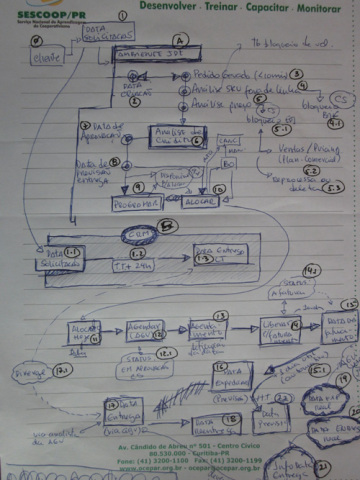
Figure 1.16 Process mapping, start
This initial session identified a total of 34 elements. As the process mapping occurred, complementary data was analyzed, and observation happened; this initial picture evolved into a final validated version with 135 activities identified.
The methodology used to draw the flows may vary according to the final goals. Some of the best-known business process mapping methodologies2 are, in alphabetic order, business model canvas, business process discovery, business process modeling, ethnography, IDEF, OBASHI, N2 Chart, organizational studies, process-centered design, SADT, systems engineering, value stream mapping, and workflow.
Once early, unconnected flows generated during first interviews are available, the mapping team can create more comprehensive diagrams. Although some teams would prefer to go electronic, this phase is usually done with pencil and paper because there is still much to find out about the process and rework is likely to be necessary before any fine-tuning activities.
The first round of flows builds a scenario similar to a puzzle. Often, a wide panel (or wall) is used to offer a complete view of the processes being mapped. Recent and old versions are usually side by side to facilitate overall visibility.
Some elements:
- 0 Client
- 1 Order request date
- 2 Order creation date
- 4 SKU analysis
- 5 Price analysis
- 6 Credit analysis
- 8 Define delivery date
- 12 Schedule delivery
- 15 Invoicing
- 16 Shipping
21 Delivery confirmation
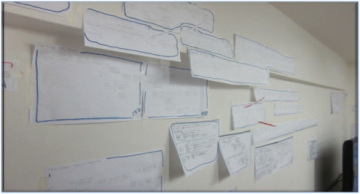
Figure 1.17 First-round flows
Depending on the magnitude of the mapping efforts, a “war room” may be used to create a focused environment. More comprehensive projects involving larger teams and longer schedules will benefit from the structure of a war room. Figure 1.18 shows the war room used for a project at GE Transportation. This team worked simultaneously on 9 maps and created 49 flows connected to each other.
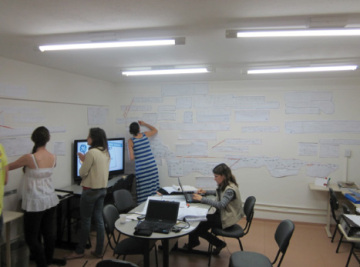
Figure 1.18 War room
Some complementary interviews are expected during the phase of drawing the first round of flows. Additional sessions are usually required before the preliminary flows are done. The goal of preliminary flows is to organize all information captured so far in a format detailed enough to go into a thorough presentation to those who were interviewed. The next figure shows a war room where processes are organized on different walls. These maps were to go through a two-day session with the interviewees.
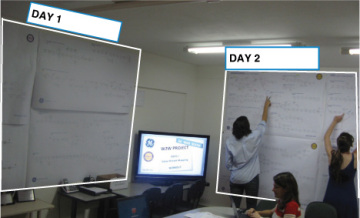
Figure 1.19 Preliminary flows
Following the adjustments resulting from the presentation of the preliminary flows to the interviewees, it is now time to complete the process diagnosis with in loco observation and data analysis. Each project is unique. Therefore, the selection of what data must be analyzed or what processes need observation do not follow a standard pattern. The process mapping team frequently plays detective in this phase.

Figure 1.20 Refining flows, data analysis, and observation
Any process mapping must be executed with a clear purpose. The diagnosis will always be more efficient when a target has been defined in the early stages. Examples of these targets include the identification of:
- Low-productivity activities
- Activities with an interface with information systems
- Processes that generate inventory divergence
- Processes that cause customer dissatisfaction
- Any other approach that will improve organizational performance in any area of the business
There are infinite possible targets to a process mapping exercise.
Business Case
This process mapping was chosen to understand the root causes for recurrent inventory divergence in an external manufacturing facility that serves a large multinational electronics industry headquartered in the United States. This case is inspired by an operation that includes three mobile assembly lines, one parts warehouse, and one finished goods distribution center.
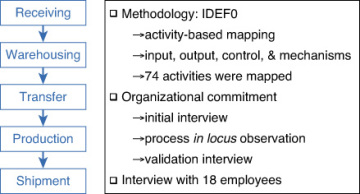
Figure 1.21 Case, scope
The mapping methodology used was IDEF0. Five processes were mapped: receiving, warehousing, transfer, production, and shipment. A total of 18 employees were interviewed and 74 activities identified. The goal of the mapping was to identify the cause of recurrent inventory divergence.
Each of the five processes was diagnosed after interviews, in loco observation, and data analysis. This diagram indicates 5 activities out of 12 are vulnerable and inventory divergence may occur. Note these items are parts for mobile devices. They are very small pieces; some of them can hardly be seen.
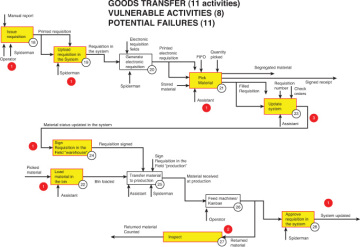
Figure 1.22 Case, map
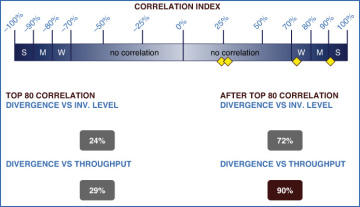
Figure 1.23 Case, analysis
A detailed data analysis investigated the eventual correlation between inventory divergence and inventory holding or volume throughput. Throughput was shown to be correlated to the divergence of 80% of the items. These items represented only 45% of the divergence in value.
The challenge is then to identify the reason why 20% of the items generate 55% of the divergence.
Other analyses were done, such as inventory aging and divergence value by shift and by operator.
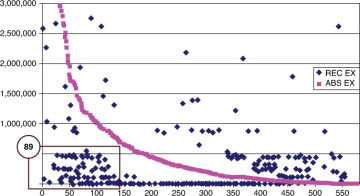
Figure 1.24 Case, analysis 2
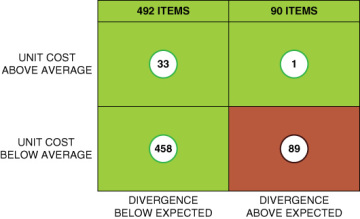
Figure 1.25 Case, analysis 3
A possible cause was the unit value of these items. If these 89 items (20% of total) had a unit cost above the average unit cost, this could explain why their divergence summed such a high value. But all these items with high value divergence had a unit cost below the average unit cost.
It was during the observation in loco of the manufacturing operation that one of the consultants noticed a junior operator was sweeping some items that were on the floor of the production area. When the consultant asked where these little items come from, the operator indicated three equipments (as circled in the map).
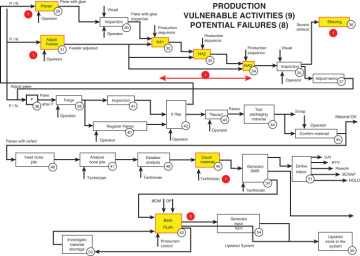
Figure 1.26 Case, diagnosis
Conclusion
These three process equipments identified in the production flow faced some performance issues and several small parts that were processed through them were systematically being scrapped without being properly registered. The company would only acknowledge the missing components during inventory audit, but would not be able to track them back to the root cause. The combination of several factors affected 80% of the items that responded to 45% of inventory divergence. This required process improvements in all mapped areas. And a single factor related to the manufacturing operation caused 55% of divergence by not registering losses on 89 items, which represented 20% of total stock keeping units (SKUs). As a consequence of the process mapping, the following report was issued. Some information has been omitted due to confidentiality reasons.
Project Report: Sample
A) SUMMARY
There is a weak correlation between the generated divergence and the product quantity in stock.
A strong correlation exists between the generated divergence and the product quantity put into motion by the company.
The items that generated more divergence (top 80) don’t fit into the patterns of correlation cited above, so they require better research.
Some items have a higher % of losses than expected.
Items with a % of losses higher than the expected can be originated by production activities.
There is strong evidence of failures in the records of material transferences for the production and from the process of finished goods audit (FGA).
There are generalized failures on all stages of material flow, with weak or nonexistent controls.
There are three systems for the control/identification of divergences:
Cycle count, which is inefficient
FGA, which is a reactive system and therefore inefficient on the prevention of divergences
Physical inventory, an equally reactive system
There are points of vulnerability in the production associated with not reporting all losses.
There are failures in the internal communication of operational problems.
There are conflicts of interest in the hierarchy of decision making, from the top down and the bottom up.
The impact of failures in the material flows is reflected in the materials divergence on the work in progress (WIP), but is not generated totally in the production
B) Transformation Plan: Basic Steps
- Phase 1: Elaboration/review of approximately 40 procedures (receiving, warehousing, and transference to production). Implementation of actions plans.
- Phase 2: Parallel to phase 1. Elaboration and implementation of continuous training program.
- Phase 3: After phases 1 and 2. Complete review and implementation of an independent cycle count program.
- Phase 4: Parallel to phases 1, 2, and 3. Elaboration or review of approximately 27 procedures (production & expedition). Implementation of action plans for those areas.
- Phase 5. After phases 3 and 4. Implementation of a process-based audit with total independence, on a daily basis, reporting to the site top management.
C) Potential Barriers to Implementation
Reorganization of the internal communication system
High turnover of employees
Overloaded leading team (supervisors/managers)
Leading team (supervisors/managers) with little experience on:
Procedures elaboration techniques
Internal audit techniques
Cycle count program (design, start-up, rollout, ongoing)
Many vulnerable activities that must be adjusted simultaneously
D) Loss-Elimination Scenarios
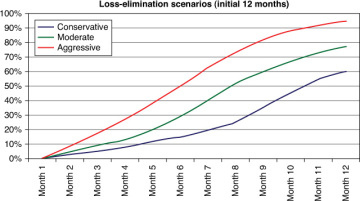
Figure 1.27 Loss-elimination scenarios, 12 months
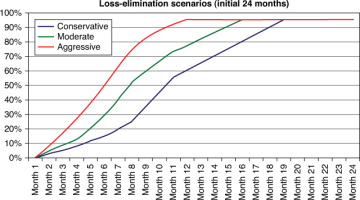
Figure 1.28 Loss-elimination scenarios, 24 months
Validated Flows
At this time, nearly all the information has been captured in various interviews, innumerable data has been analyzed, and all significant processes have been observed in loco.
This session differs from previous ones because it is not an interview. Ideally, the interlocutor will only confirm that the presentation is accurate and represents the processes mapped with high fidelity. If relevant, new information comes up at this time; this will indicate that the previous stages have not been properly done.
The format this connected puzzle presents is varied; there is no golden rule. The more information the mapping team has captured, the more resources will be available to illustrate this final flow.
The following image is based on the process mapping of a warehousing operation of a retailer. Note the arrows indicate correlations between different subprocesses. Some graphs (histograms) offer a time-based approach to the process map.
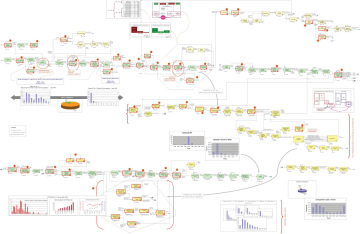
Figure 1.29 Disclaimer: The processes identified in this map will vary based on the organization/industry goals, and so readability (or nonreadability, in this case) is not a factor for example purposes here.
Although the final version of the flow may offer a comprehensive perspective of the mapped processes, it is impossible to converge into it all the information captured during the interviews, data analysis, and in loco observations. The use of complementary organized data is therefore fundamental.
Given the popularity of spreadsheets, these are commonly the best way to organize all information captured during the mapping process. The format is highly customized according to the outputs of the project. Note that each line of the spreadsheet represents one specific activity mapped.
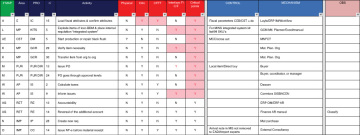
Figure 1.30 Example of organized data